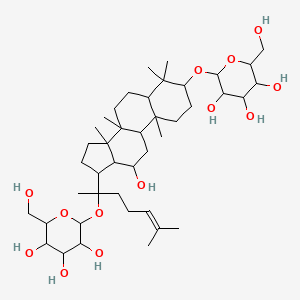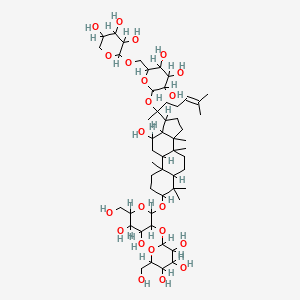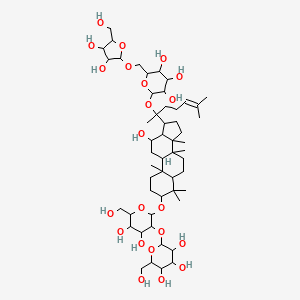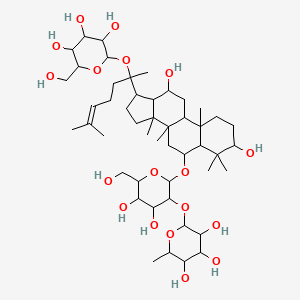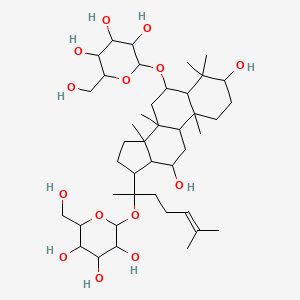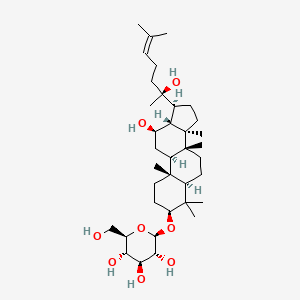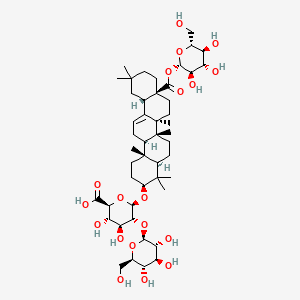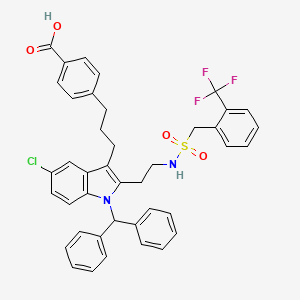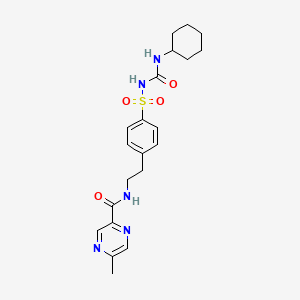
Glipizid
Übersicht
Beschreibung
Glipizid ist ein orales Antidiabetikum, das zur Klasse der Sulfonylharnstoff-Medikamente der zweiten Generation gehört. Es wird hauptsächlich zur Kontrolle des Blutzuckerspiegels bei Patienten mit Typ-2-Diabetes mellitus eingesetzt. This compound wirkt, indem es die Bauchspeicheldrüse zur Insulinausschüttung anregt und die Empfindlichkeit des Gewebes gegenüber Insulin erhöht . Es wurde erstmals 1984 eingeführt und ist unter verschiedenen Markennamen erhältlich, darunter Glucotrol .
Wissenschaftliche Forschungsanwendungen
Glipizid hat eine breite Palette von Anwendungen in der wissenschaftlichen Forschung, insbesondere in den Bereichen Chemie, Biologie, Medizin und Industrie. In der Medizin wird es zur Kontrolle des Blutzuckerspiegels bei Patienten mit Typ-2-Diabetes mellitus eingesetzt . In der Chemie wird this compound hinsichtlich seines thermischen Verhaltens und seiner polymorphen Formen untersucht, wobei Techniken wie Differenzthermoanalyse (DSC), Thermogravimetrie (TGA), Röntgenpulverdiffraktometrie (XRPD) und Fourier-Transformations-Infrarotspektroskopie (FT-IR) verwendet werden . Diese Studien helfen beim Verständnis des Verhaltens von pharmazeutischen Feststoffen und der Sicherstellung der Reproduzierbarkeit von industriellen Chargen .
Wirkmechanismus
This compound übt seine Wirkung aus, indem es die Beta-Zellen der Langerhans'schen Inseln der Bauchspeicheldrüse für die Insulinreaktion sensibilisiert. Es blockiert teilweise die Kaliumkanäle zwischen den Beta-Zellen, was zu einer Zelldepolarisation und der Öffnung spannungsabhängiger Kalziumkanäle führt. Der resultierende Kalziumeinstrom fördert die Insulinausschüttung aus den Beta-Zellen . Dieser Mechanismus trägt dazu bei, den Blutzuckerspiegel zu senken, indem die Insulinausschüttung gefördert und die Empfindlichkeit des Gewebes gegenüber Insulin erhöht wird .
Wirkmechanismus
Target of Action
Glipizide primarily targets the beta cells of the pancreatic islets of Langerhans . These cells play a crucial role in the regulation of blood glucose levels by producing and releasing insulin, a hormone that promotes the uptake and utilization of glucose by the body’s cells .
Mode of Action
Glipizide acts by sensitizing these beta cells to the presence of glucose in the blood . This means that more insulin is released in response to glucose than would be without glipizide ingestion . Specifically, glipizide achieves this by partially blocking potassium channels among beta cells . This blocking action causes the cells to depolarize, which results in the opening of voltage-gated calcium channels. The resulting influx of calcium encourages the release of insulin from the beta cells .
Biochemical Pathways
The primary biochemical pathway affected by glipizide is the insulin signaling pathway . By stimulating the release of insulin, glipizide enhances the body’s ability to lower blood glucose levels. Insulin binds to its receptors on various body cells, triggering a cascade of events that lead to the uptake and utilization of glucose .
Pharmacokinetics
Glipizide is rapidly and completely absorbed following oral administration . The absolute bioavailability of glipizide was found to be 100% after single oral doses in patients with type 2 diabetes mellitus . The mean terminal elimination half-life of glipizide ranged from 2 to 5 hours after single or multiple doses in patients with type 2 diabetes mellitus . These properties contribute to its effectiveness as a blood glucose-lowering agent .
Result of Action
The primary result of glipizide’s action is a decrease in blood glucose levels . By stimulating the release of insulin from the pancreas, glipizide promotes the uptake and utilization of glucose by the body’s cells, thereby lowering blood glucose levels . This makes glipizide an effective treatment for type 2 diabetes mellitus, a condition characterized by higher-than-normal levels of blood glucose .
Action Environment
The action, efficacy, and stability of glipizide can be influenced by various environmental factors. For instance, the presence of food in the stomach can slow down the absorption of glipizide, potentially affecting its onset of action . Additionally, the drug’s effectiveness can be influenced by the patient’s adherence to a diabetic diet and exercise regimen . Furthermore, the dose of glipizide may need to be adjusted in those with liver or kidney disease , indicating that the patient’s health status can also influence the drug’s action and efficacy .
Biochemische Analyse
Biochemical Properties
Glipizide functions as an insulin secretagogue, stimulating the release of insulin from the pancreatic beta cells, thereby increasing the plasma concentrations of insulin . This action is dependent on the functional beta cells in the pancreatic islets . Glipizide binds to the sulfonylurea receptor expressed on the pancreatic beta-cell plasma membrane, leading to the closure of the ATP-sensitive potassium channel and reduced potassium conductance .
Cellular Effects
Glipizide has a significant impact on various types of cells and cellular processes. It enhances the glucose uptake into the skeletal muscles and potentiates the action of insulin in the liver . Other effects include inhibited lipolysis in the liver and adipose tissue, inhibited hepatic glucose output, and increased uptake and oxidation of glucose .
Molecular Mechanism
The molecular mechanism of Glipizide involves partially blocking potassium channels among beta cells of pancreatic islets of Langerhans . By blocking potassium channels, the cell depolarizes, which results in the opening of voltage-gated calcium channels. The resulting calcium influx encourages insulin release from beta cells .
Temporal Effects in Laboratory Settings
Pharmacodynamic analysis indicates a significant relationship between plasma glipizide concentration and reduction in Fasting Plasma Glucose (FPG) and HbA1c over a dose range of 5–60 mg, with maximal efficacy achieved at a dose of 20 mg for FPG and at 5 mg for HbA1c .
Metabolic Pathways
Glipizide is metabolized primarily by hepatic transformation into several inactive metabolites by aromatic hydroxylation . A minor metabolite, an acetylamino-ethyl-benzene derivative, is reported to have some hypoglycemic activity .
Transport and Distribution
Glipizide is extensively bound to plasma albumin and has a relatively low volume of distribution . It is eliminated by metabolic biotransformation and excretion of the metabolites in the urine .
Subcellular Localization
The subcellular localization of Glipizide is primarily within the beta cells of the pancreatic islets of Langerhans . Here, it acts by partially blocking potassium channels, leading to cell depolarization and the subsequent release of insulin .
Vorbereitungsmethoden
Synthesewege und Reaktionsbedingungen: Die Synthese von Glipizid umfasst mehrere Schritte, beginnend mit 4-[2-(5-Methylpyrazin-2-carboxamido)ethyl]benzolsulfonamid. Die wichtigsten Schritte umfassen die Chlorierung, gefolgt von der Reaktion mit Cyclohexylamin in Gegenwart eines Eisenkatalysators und Kohlenmonoxids . Diese Methode ist einfach und praktikabel und bietet einen neuen Prozessweg für die Synthese von this compound .
Industrielle Produktionsverfahren: In industriellen Umgebungen wird this compound häufig unter Verwendung von Lösungsmitteleindampfungsverfahren hergestellt, um seine Löslichkeit zu verbessern. Feste Dispersionen von this compound werden unter Verwendung von Polymeren wie Polyvinylpyrrolidon (PVP) und Polyethylenglykol (PEG) hergestellt. Die Verhältnisse von Arzneimittel zu Polymer und die Bedingungen für die Lösungsmitteleindampfung werden optimiert, um die gewünschte Löslichkeit und Auflösung zu erreichen .
Analyse Chemischer Reaktionen
Arten von Reaktionen: Glipizid unterliegt verschiedenen chemischen Reaktionen, darunter Oxidation, Reduktion und Substitution. Es ist bekannt, dass die Verbindung beim Erhitzen zerfällt und zur Bildung von 5-Methyl-N-[2-(4-Sulfamoylphenyl)ethyl]pyrazin-2-carboxamid führt .
Häufige Reagenzien und Bedingungen: Häufige Reagenzien, die bei den Reaktionen mit this compound verwendet werden, sind Eisenkatalysatoren, Kohlenmonoxid und Cyclohexylamin . Der Zersetzungsprozess beinhaltet die Gasentwicklung, einschließlich Cyclohexanamin und Kohlendioxid .
Hauptprodukte: Die Hauptprodukte, die aus der Zersetzung von this compound gebildet werden, umfassen 5-Methyl-N-[2-(4-Sulfamoylphenyl)ethyl]pyrazin-2-carboxamid .
Vergleich Mit ähnlichen Verbindungen
Ähnliche Verbindungen: Glipizid wird häufig mit anderen Sulfonylharnstoff-Medikamenten wie Glimepirid und Glyburid verglichen. Es wird auch mit Nicht-Sulfonylharnstoff-Medikamenten wie Metformin und Inkretin-Mimetika wie Semaglutid verglichen .
Einzigartigkeit: Im Vergleich zu anderen Sulfonylharnstoffen zeichnet sich this compound durch eine schnelle Absorption und Wirkungsgeschwindigkeit sowie durch die kürzeste Halbwertszeit und Wirkdauer aus. Dies reduziert das Risiko einer lang anhaltenden Hypoglykämie, die häufig bei anderen blutzuckersenkenden Mitteln beobachtet wird . Darüber hinaus verstärkt die einzigartige chemische Struktur von this compound, die eine unpolare Seitenkette umfasst, seine hypoglykämische Potenz .
Eigenschaften
IUPAC Name |
N-[2-[4-(cyclohexylcarbamoylsulfamoyl)phenyl]ethyl]-5-methylpyrazine-2-carboxamide | |
|---|---|---|
| Source | PubChem | |
| URL | https://pubchem.ncbi.nlm.nih.gov | |
| Description | Data deposited in or computed by PubChem | |
InChI |
InChI=1S/C21H27N5O4S/c1-15-13-24-19(14-23-15)20(27)22-12-11-16-7-9-18(10-8-16)31(29,30)26-21(28)25-17-5-3-2-4-6-17/h7-10,13-14,17H,2-6,11-12H2,1H3,(H,22,27)(H2,25,26,28) | |
| Source | PubChem | |
| URL | https://pubchem.ncbi.nlm.nih.gov | |
| Description | Data deposited in or computed by PubChem | |
InChI Key |
ZJJXGWJIGJFDTL-UHFFFAOYSA-N | |
| Source | PubChem | |
| URL | https://pubchem.ncbi.nlm.nih.gov | |
| Description | Data deposited in or computed by PubChem | |
Canonical SMILES |
CC1=CN=C(C=N1)C(=O)NCCC2=CC=C(C=C2)S(=O)(=O)NC(=O)NC3CCCCC3 | |
| Source | PubChem | |
| URL | https://pubchem.ncbi.nlm.nih.gov | |
| Description | Data deposited in or computed by PubChem | |
Molecular Formula |
C21H27N5O4S | |
| Source | PubChem | |
| URL | https://pubchem.ncbi.nlm.nih.gov | |
| Description | Data deposited in or computed by PubChem | |
DSSTOX Substance ID |
DTXSID0040676 | |
| Record name | Glipizide | |
| Source | EPA DSSTox | |
| URL | https://comptox.epa.gov/dashboard/DTXSID0040676 | |
| Description | DSSTox provides a high quality public chemistry resource for supporting improved predictive toxicology. | |
Molecular Weight |
445.5 g/mol | |
| Source | PubChem | |
| URL | https://pubchem.ncbi.nlm.nih.gov | |
| Description | Data deposited in or computed by PubChem | |
Physical Description |
Solid | |
| Record name | Glipizide | |
| Source | Human Metabolome Database (HMDB) | |
| URL | http://www.hmdb.ca/metabolites/HMDB0015200 | |
| Description | The Human Metabolome Database (HMDB) is a freely available electronic database containing detailed information about small molecule metabolites found in the human body. | |
| Explanation | HMDB is offered to the public as a freely available resource. Use and re-distribution of the data, in whole or in part, for commercial purposes requires explicit permission of the authors and explicit acknowledgment of the source material (HMDB) and the original publication (see the HMDB citing page). We ask that users who download significant portions of the database cite the HMDB paper in any resulting publications. | |
Solubility |
>66.8 [ug/mL] (The mean of the results at pH 7.4), 1.64e-02 g/L | |
| Record name | SID855947 | |
| Source | Burnham Center for Chemical Genomics | |
| URL | https://pubchem.ncbi.nlm.nih.gov/bioassay/1996#section=Data-Table | |
| Description | Aqueous solubility in buffer at pH 7.4 | |
| Record name | Glipizide | |
| Source | DrugBank | |
| URL | https://www.drugbank.ca/drugs/DB01067 | |
| Description | The DrugBank database is a unique bioinformatics and cheminformatics resource that combines detailed drug (i.e. chemical, pharmacological and pharmaceutical) data with comprehensive drug target (i.e. sequence, structure, and pathway) information. | |
| Explanation | Creative Common's Attribution-NonCommercial 4.0 International License (http://creativecommons.org/licenses/by-nc/4.0/legalcode) | |
| Record name | Glipizide | |
| Source | Human Metabolome Database (HMDB) | |
| URL | http://www.hmdb.ca/metabolites/HMDB0015200 | |
| Description | The Human Metabolome Database (HMDB) is a freely available electronic database containing detailed information about small molecule metabolites found in the human body. | |
| Explanation | HMDB is offered to the public as a freely available resource. Use and re-distribution of the data, in whole or in part, for commercial purposes requires explicit permission of the authors and explicit acknowledgment of the source material (HMDB) and the original publication (see the HMDB citing page). We ask that users who download significant portions of the database cite the HMDB paper in any resulting publications. | |
Mechanism of Action |
Type 2 diabetes mellitus (T2DM) is a chronic metabolic disorder with increasing prevalence worldwide. Characterized by higher-than-normal levels of blood glucose, T2DM is a complex disorder that arises from the interaction between genetic, environmental and behavioral risk factors. Insulin is a peptide hormone that plays a critical role in regulating blood glucose levels. In response to high blood glucose levels, insulin promotes the uptake of glucose into the liver, muscle cells, and fat cells for storage. Although there are multiple events occurring that lead to the pathophysiology of T2DM, the disorder mainly involves insulin insensitivity as a result of insulin resistance, declining insulin production, and eventual failure of beta cells of pancreatic islets that normally produce insulin. Early management with lifestyle intervention, such as controlled diet and exercise, is critical in reducing the risk of long-term secondary complications, such as cardiovascular mortality. Glipizide, like other sulfonylurea drugs, is an insulin secretagogue, which works by stimulating the insulin release from the pancreatic beta cells thereby increasing the plasma concentrations of insulin. Thus, the main therapeutic action of the drug depends on the functional beta cells in the pancreatic islets. Sulfonylureas bind to the sulfonylurea receptor expressed on the pancreatic beta-cell plasma membrane, leading to the closure of the ATP-sensitive potassium channel and reduced potassium conductance. This results in depolarization of the pancreatic beta cell and opening of the voltage-sensitive calcium channels, promoting calcium ion influx. Increased intracellular concentrations of calcium ions in beta cells stimulates the secretion, or exocytosis, of insulin granules from the cells. Apart from this main mechanism of action, the blood-glucose-lowering effect of glipizide involves increased peripheral glucose utilization via stimulating hepatic gluconeogenesis and by increasing the number and sensitivity of insulin receptors. | |
| Record name | Glipizide | |
| Source | DrugBank | |
| URL | https://www.drugbank.ca/drugs/DB01067 | |
| Description | The DrugBank database is a unique bioinformatics and cheminformatics resource that combines detailed drug (i.e. chemical, pharmacological and pharmaceutical) data with comprehensive drug target (i.e. sequence, structure, and pathway) information. | |
| Explanation | Creative Common's Attribution-NonCommercial 4.0 International License (http://creativecommons.org/licenses/by-nc/4.0/legalcode) | |
CAS No. |
29094-61-9 | |
| Record name | Glipizide | |
| Source | CAS Common Chemistry | |
| URL | https://commonchemistry.cas.org/detail?cas_rn=29094-61-9 | |
| Description | CAS Common Chemistry is an open community resource for accessing chemical information. Nearly 500,000 chemical substances from CAS REGISTRY cover areas of community interest, including common and frequently regulated chemicals, and those relevant to high school and undergraduate chemistry classes. This chemical information, curated by our expert scientists, is provided in alignment with our mission as a division of the American Chemical Society. | |
| Explanation | The data from CAS Common Chemistry is provided under a CC-BY-NC 4.0 license, unless otherwise stated. | |
| Record name | Glipizide [USAN:USP:INN:BAN] | |
| Source | ChemIDplus | |
| URL | https://pubchem.ncbi.nlm.nih.gov/substance/?source=chemidplus&sourceid=0029094619 | |
| Description | ChemIDplus is a free, web search system that provides access to the structure and nomenclature authority files used for the identification of chemical substances cited in National Library of Medicine (NLM) databases, including the TOXNET system. | |
| Record name | Glipizide | |
| Source | DrugBank | |
| URL | https://www.drugbank.ca/drugs/DB01067 | |
| Description | The DrugBank database is a unique bioinformatics and cheminformatics resource that combines detailed drug (i.e. chemical, pharmacological and pharmaceutical) data with comprehensive drug target (i.e. sequence, structure, and pathway) information. | |
| Explanation | Creative Common's Attribution-NonCommercial 4.0 International License (http://creativecommons.org/licenses/by-nc/4.0/legalcode) | |
| Record name | glipizide | |
| Source | DTP/NCI | |
| URL | https://dtp.cancer.gov/dtpstandard/servlet/dwindex?searchtype=NSC&outputformat=html&searchlist=759120 | |
| Description | The NCI Development Therapeutics Program (DTP) provides services and resources to the academic and private-sector research communities worldwide to facilitate the discovery and development of new cancer therapeutic agents. | |
| Explanation | Unless otherwise indicated, all text within NCI products is free of copyright and may be reused without our permission. Credit the National Cancer Institute as the source. | |
| Record name | Glipizide | |
| Source | EPA DSSTox | |
| URL | https://comptox.epa.gov/dashboard/DTXSID0040676 | |
| Description | DSSTox provides a high quality public chemistry resource for supporting improved predictive toxicology. | |
| Record name | Glipizide | |
| Source | European Chemicals Agency (ECHA) | |
| URL | https://echa.europa.eu/substance-information/-/substanceinfo/100.044.919 | |
| Description | The European Chemicals Agency (ECHA) is an agency of the European Union which is the driving force among regulatory authorities in implementing the EU's groundbreaking chemicals legislation for the benefit of human health and the environment as well as for innovation and competitiveness. | |
| Explanation | Use of the information, documents and data from the ECHA website is subject to the terms and conditions of this Legal Notice, and subject to other binding limitations provided for under applicable law, the information, documents and data made available on the ECHA website may be reproduced, distributed and/or used, totally or in part, for non-commercial purposes provided that ECHA is acknowledged as the source: "Source: European Chemicals Agency, http://echa.europa.eu/". Such acknowledgement must be included in each copy of the material. ECHA permits and encourages organisations and individuals to create links to the ECHA website under the following cumulative conditions: Links can only be made to webpages that provide a link to the Legal Notice page. | |
| Record name | GLIPIZIDE | |
| Source | FDA Global Substance Registration System (GSRS) | |
| URL | https://gsrs.ncats.nih.gov/ginas/app/beta/substances/X7WDT95N5C | |
| Description | The FDA Global Substance Registration System (GSRS) enables the efficient and accurate exchange of information on what substances are in regulated products. Instead of relying on names, which vary across regulatory domains, countries, and regions, the GSRS knowledge base makes it possible for substances to be defined by standardized, scientific descriptions. | |
| Explanation | Unless otherwise noted, the contents of the FDA website (www.fda.gov), both text and graphics, are not copyrighted. They are in the public domain and may be republished, reprinted and otherwise used freely by anyone without the need to obtain permission from FDA. Credit to the U.S. Food and Drug Administration as the source is appreciated but not required. | |
| Record name | Glipizide | |
| Source | Human Metabolome Database (HMDB) | |
| URL | http://www.hmdb.ca/metabolites/HMDB0015200 | |
| Description | The Human Metabolome Database (HMDB) is a freely available electronic database containing detailed information about small molecule metabolites found in the human body. | |
| Explanation | HMDB is offered to the public as a freely available resource. Use and re-distribution of the data, in whole or in part, for commercial purposes requires explicit permission of the authors and explicit acknowledgment of the source material (HMDB) and the original publication (see the HMDB citing page). We ask that users who download significant portions of the database cite the HMDB paper in any resulting publications. | |
Melting Point |
200-203, 208 - 209 °C | |
| Record name | Glipizide | |
| Source | DrugBank | |
| URL | https://www.drugbank.ca/drugs/DB01067 | |
| Description | The DrugBank database is a unique bioinformatics and cheminformatics resource that combines detailed drug (i.e. chemical, pharmacological and pharmaceutical) data with comprehensive drug target (i.e. sequence, structure, and pathway) information. | |
| Explanation | Creative Common's Attribution-NonCommercial 4.0 International License (http://creativecommons.org/licenses/by-nc/4.0/legalcode) | |
| Record name | Glipizide | |
| Source | Human Metabolome Database (HMDB) | |
| URL | http://www.hmdb.ca/metabolites/HMDB0015200 | |
| Description | The Human Metabolome Database (HMDB) is a freely available electronic database containing detailed information about small molecule metabolites found in the human body. | |
| Explanation | HMDB is offered to the public as a freely available resource. Use and re-distribution of the data, in whole or in part, for commercial purposes requires explicit permission of the authors and explicit acknowledgment of the source material (HMDB) and the original publication (see the HMDB citing page). We ask that users who download significant portions of the database cite the HMDB paper in any resulting publications. | |
Retrosynthesis Analysis
AI-Powered Synthesis Planning: Our tool employs the Template_relevance Pistachio, Template_relevance Bkms_metabolic, Template_relevance Pistachio_ringbreaker, Template_relevance Reaxys, Template_relevance Reaxys_biocatalysis model, leveraging a vast database of chemical reactions to predict feasible synthetic routes.
One-Step Synthesis Focus: Specifically designed for one-step synthesis, it provides concise and direct routes for your target compounds, streamlining the synthesis process.
Accurate Predictions: Utilizing the extensive PISTACHIO, BKMS_METABOLIC, PISTACHIO_RINGBREAKER, REAXYS, REAXYS_BIOCATALYSIS database, our tool offers high-accuracy predictions, reflecting the latest in chemical research and data.
Strategy Settings
| Precursor scoring | Relevance Heuristic |
|---|---|
| Min. plausibility | 0.01 |
| Model | Template_relevance |
| Template Set | Pistachio/Bkms_metabolic/Pistachio_ringbreaker/Reaxys/Reaxys_biocatalysis |
| Top-N result to add to graph | 6 |
Feasible Synthetic Routes
Q1: What is the primary mechanism of action of Glipizide?
A1: Glipizide exerts its hypoglycemic effect by binding to and blocking ATP-sensitive potassium (KATP) channels on the surface of pancreatic β-cells. [] This blockage depolarizes the β-cell membrane, leading to the opening of voltage-gated calcium channels. The subsequent influx of calcium ions triggers the exocytosis of insulin-containing granules, thereby increasing insulin secretion. [, ]
Q2: Does Glipizide only impact insulin secretion?
A2: While primarily recognized for enhancing insulin secretion, studies suggest that Glipizide might also influence insulin metabolism and peripheral glucose disposal. In obese type II diabetic patients, Glipizide treatment increased insulin metabolism, potentially within the liver. [] Additionally, it increased insulin-mediated peripheral glucose disposal in secondary failure type 2 diabetic patients. []
Q3: Can Glipizide affect glucose absorption?
A3: While initial studies suggested Glipizide might suppress xylose absorption in diet-controlled diabetics, further research revealed no such effect in insulin-dependent diabetics. [] This suggests that Glipizide's impact on postprandial glucose levels is primarily due to enhanced insulin secretion rather than altered absorption.
Q4: What is the molecular formula and weight of Glipizide?
A4: Glipizide (C21H27N5O4S) has a molecular weight of 445.55 g/mol. [, ]
Q5: Are there any spectroscopic data available for Glipizide?
A5: Yes, various spectroscopic techniques have been employed to characterize Glipizide. Fourier-transform infrared (FTIR) spectroscopy has been used to analyze Glipizide's stability and interactions with excipients in formulations like solid dispersions and bilayer tablets. [, , ] Additionally, differential scanning calorimetry (DSC) and X-ray diffraction (XRD) studies have revealed the amorphous nature of Glipizide in solid dispersions. []
Q6: What is the stability of Glipizide in various formulations?
A6: Glipizide stability has been investigated in various formulations. Studies demonstrate its stability in solid dispersions with low viscosity grade Hydroxypropyl methylcellulose (HPMCLV), even after storage. [] Bilayer tablet formulations with Hydroxypropyl methylcellulose (HPMC) and Ethyl Cellulose (EC) also exhibited stability according to ICH guidelines. []
Q7: Are there any known compatibility issues with Glipizide?
A7: While generally stable, certain drug interactions can impact Glipizide's effectiveness. For instance, co-administration with Nicorandil in diabetic mice hindered the glucose-lowering effects of Glipizide. [] Therefore, careful consideration is crucial when co-administering Glipizide with other medications.
Q8: How is Glipizide absorbed and metabolized?
A8: Glipizide is well-absorbed after oral administration. [] Food delays its absorption, unlike Glyburide. [] Glipizide undergoes extensive hepatic metabolism, and both metabolites and the unchanged drug are excreted in urine. []
Q9: What is the elimination half-life of Glipizide?
A9: Glipizide exhibits a short elimination half-life ranging from 2 to 7 hours. [] Its short half-life necessitates frequent dosing or the use of extended-release formulations to maintain therapeutic efficacy.
Q10: Are there any known drug interactions that affect Glipizide pharmacokinetics?
A11: Yes, several drugs can influence Glipizide pharmacokinetics. Clarithromycin significantly inhibits its metabolism in rabbits, leading to higher Glipizide exposure. [] Additionally, Esomeprazole, a proton pump inhibitor, can increase Glipizide concentration and AUC (area under the curve) by inhibiting Cytochrome P-450 enzymes responsible for its metabolism. []
Q11: What animal models have been used to investigate the effects of Glipizide?
A11: Various animal models have been employed, including:
- Diabetic-prone BB rats: Demonstrated Glipizide's ability to prevent diabetes and reduce islet inflammation. []
- Healthy and diabetic rabbits: Used to study the influence of drugs like Clarithromycin [] and Puerarin [] on Glipizide pharmacokinetics.
- Healthy cats: Investigated transdermal application of Glipizide. []
- Healthy and endotoxemic sheep: Studied the effects of Glipizide on cardiopulmonary hemodynamics and oxygen transport. []
- Alloxan-induced diabetic rats: Assessed the combined effect of Glipizide and alpha lipoic acid on diabetic parameters and hepatic function. []
Q12: How effective is Glipizide in controlling blood glucose levels compared to other treatments?
A12: Studies have compared Glipizide's efficacy to other treatments:
- Glyburide: In a Veterans Health Administration study, converting from Glyburide to Glipizide increased HbA1c levels, but reduced the incidence of hypoglycemia. []
Q13: How does Glipizide's low solubility affect its formulation?
A15: Glipizide's low solubility (BCS Class II drug) poses challenges for formulation and can limit its bioavailability. [, ] Various strategies have been explored to enhance its solubility and dissolution rate.
Q14: What formulation strategies have been investigated to improve Glipizide delivery?
A14: Several approaches have been explored to enhance Glipizide delivery:
- Solid Dispersions: Utilizing low viscosity grade HPMCLV improved Glipizide's dissolution rate. []
- Nano-complexes: Glipizide-Phospholipid nano-complexes demonstrated improved solubility and bioavailability in rats. []
- Microspheres: Ethyl Cellulose microspheres showed potential for sustained Glipizide release. []
- Transdermal Delivery: Studies explored transdermal patches incorporating Glipizide-cyclodextrin complexes and penetration enhancers, achieving sustained drug release and therapeutic effects in diabetic rats. []
Q15: Have any specific cyclodextrins shown promise in enhancing Glipizide solubility?
A17: Yes, complexation with cyclodextrins, especially Dimethyl-beta-cyclodextrin (DM-beta-CyD), significantly improved Glipizide release and permeation through rat skin in transdermal formulations. []
Q16: What is the rationale behind developing a transdermal delivery system for Glipizide?
A18: Transdermal delivery of Glipizide aims to address the limitations of oral therapy, such as fluctuating bioavailability, risk of severe hypoglycemia, and gastric disturbances. []
Haftungsausschluss und Informationen zu In-Vitro-Forschungsprodukten
Bitte beachten Sie, dass alle Artikel und Produktinformationen, die auf BenchChem präsentiert werden, ausschließlich zu Informationszwecken bestimmt sind. Die auf BenchChem zum Kauf angebotenen Produkte sind speziell für In-vitro-Studien konzipiert, die außerhalb lebender Organismen durchgeführt werden. In-vitro-Studien, abgeleitet von dem lateinischen Begriff "in Glas", beinhalten Experimente, die in kontrollierten Laborumgebungen unter Verwendung von Zellen oder Geweben durchgeführt werden. Es ist wichtig zu beachten, dass diese Produkte nicht als Arzneimittel oder Medikamente eingestuft sind und keine Zulassung der FDA für die Vorbeugung, Behandlung oder Heilung von medizinischen Zuständen, Beschwerden oder Krankheiten erhalten haben. Wir müssen betonen, dass jede Form der körperlichen Einführung dieser Produkte in Menschen oder Tiere gesetzlich strikt untersagt ist. Es ist unerlässlich, sich an diese Richtlinien zu halten, um die Einhaltung rechtlicher und ethischer Standards in Forschung und Experiment zu gewährleisten.


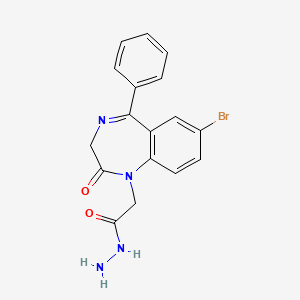
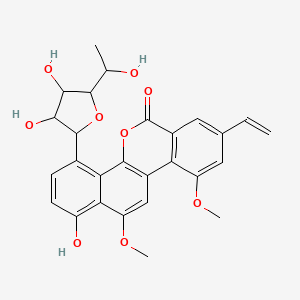
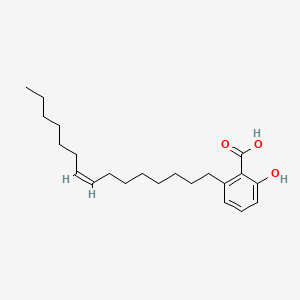
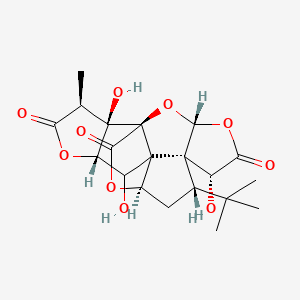
![(1R,3R,6R,7S,8S,9R,10S,11R,12S,13S,16S,17R)-8-tert-butyl-6,9,12,17-tetrahydroxy-16-methyl-2,4,14,19-tetraoxahexacyclo[8.7.2.01,11.03,7.07,11.013,17]nonadecane-5,15,18-trione](/img/structure/B1671514.png)
